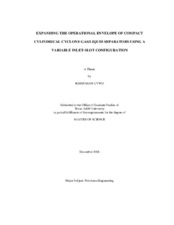| dc.description.abstract | Despite the numerous advantages associated with using compact cylindrical cyclone
gas/liquid separators, particularly for upstream production operations, the lack of a full
understanding of the complex hydrodynamic process taking place in it and its “unfamiliarity” to
oil field personnel has hindered its widespread use. The complexity associated with this
technology is attributed to two limiting physical phenomena, liquid carry-over and gas carryunder.
While a lot of work has been done to better understand and predict the liquid carry-over
operational envelope, little or no information about methods capable of adequately predicting or
characterizing the gas carry-under performance of such separators is available.
Traditionally, to mitigate the gas carry-under phenomena, the use of complex control
algorithms and systems has been employed. These systems make the technology expensive (as
opposed to the potential cost reduction it promises) and impractical for realistic use in the oil
field where reliability is of critical importance.
A simpler solution, the use of changeable or adjustable inlet-slots that regulate the artificial
gravity environment created in the separator, could significantly improve the gas carry-under
performance of cylindrical cyclone separators.
This research has focused primarily on the use of adjustable inlet-slots. Theoretical analysis
and experimental data investigating the benefits of variable inlet geometry have been provided.
This work lays the foundation or validation required to perform more tests on a field-scale
version to verify the results presented here. A modular design of such a variable inlet-slot inletsection
has the potential of simplifying the design and specifications of cylindrical cyclone
gas/liquid separators.
From the results of this investigation, it was found that the gas carry-under performance of a
cylindrical cyclone gas/liquid separator could be improved considerably over a wider range of
operating conditions by adjusting the size of the inlet-slots. This contradicts earlier reports of
liquid carry-over improvement in separator performance.
Also, for the first time, a simple method for theoretically analyzing the percent improvement
in separator gas carry-under performance using the optimum g-force concept is presented. This
method could be incorporated into design software for determining the slot-size configuration
required for varying separator-operating conditions. | en |


